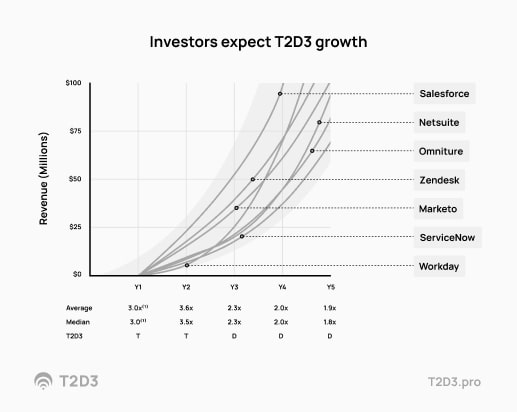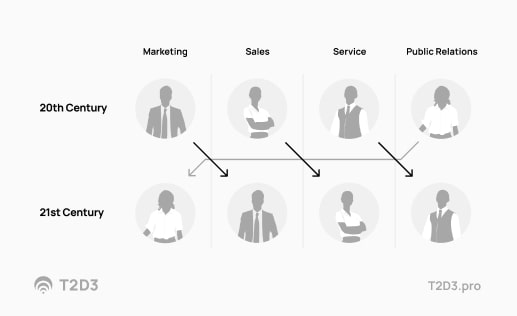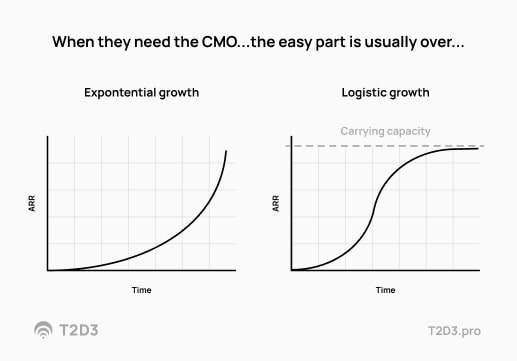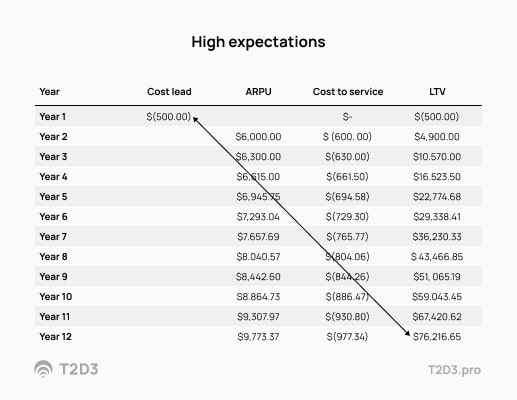It's difficult to be a marketing leader in a modern software company. The CMO is arguably the most versatile and challenging role in the executive suite. Marketing is a fast-moving and diverse discipline. Art and science make it hard for even the most well-rounded marketing leader to master all areas. Let’s explore the challenges you will face and the components that make a successful B2B SaaS CMO.
The CMO impacts the long-term success of a company. I like to say they build skyscrapers or cathedrals. There's a big difference between a CMO that does the foundational work to have excellent positioning and make the right go-to-market strategy decisions for lasting impact, like building the foundation for a skyscraper, versus doing relatively low-impact work that is still important to finish and fine-tune the various channels, messages, and campaigns. Like in a cathedral, that work will also never be finished. The CMO needs to be the architect who makes sure that everything is built strong. While it can also grow with you, it has to be built to last. Of course, you just can't do it all. You must recruit and hire people on your team to complement you.
Thick-skinned for success
The CMO always has something in their team, in their function, that's not going well. There is always something that they can be blamed or criticized for—and you have to be okay with it. You have to be comfortable that, as a CMO, there will always be mistakes and room for improvement—a spelling error in a press release or a channel that doesn't work the way everybody expected it would. You have to build a relatively thick skin, not only because you will have to deal with things that don't work but also to sustain certain things that you start. If you stop things too quickly, they will never work as well. So, you have to have that thick skin to make sure you can make some strategic bets for the company. You can see those through even when they have a rocky or uncertain beginning.
Everything can be measured these days in marketing, right? Well, true, it can. But it's also complex and misleading at times. So there’s a false expectation that marketing ROI and impact are straightforward to measure, but that's not the case. Even if you have data like website visitors or clicks on Google Ads or conversions in your funnel, that data is challenging to perfect, so there's a lot of work to make that data useful.
Many things impact the ultimate success of a marketing function that drives whether marketing turns into revenue and sustainable revenue. You have to be very careful to differentiate what's called vanity metrics from really useful KPIs.
Marketing is not all science. It's still partly art, sometimes guessing, and making gut decisions. You have to, as the CMO, get leadership and the team to follow you because you have the right balance between using data and trusting your instincts. That instinct develops from listening to customers, listening to market feedback, and mixing in some street smarts.
Utilizing the T2D3 formula
What is T2D3 growth? It's this acronym that describes a company that needs to grow at an exponential rate. You need to double and triple your ARR (annual recurring revenue). For the first two years, you need to triple it. Then, you need to double the ARR for three more years. None of this is easy, but it is the expectation often put in front of a modern marketing leader, especially of a B2B SaaS company.

The trick to accomplishing this is diversifying your demand generation - doing multiple things simultaneously. You need to be able to drive demand from multiple sources, multiple channels, inbound and outbound, a channel model and a direct model, content marketing, and paid. You have to find many different ways to drive demand. Otherwise, you cannot hit this type of exponential growth.
In addition, you need to ensure that the funnel gets optimized, i.e., the demand generation is turning into customers, into revenue, and reducing the friction in the funnel.
The third aspect is that you have to expand the revenue you get per customer, sometimes referred to as ARPU Expansion, which stands for average or annual revenue per unit. A unit usually is a user, but it could also be a customer, a site, a device, or a sensor. But ARPU expansion and getting more revenue from every customer you sell your product to is another essential element driving T2D3 growth.
Finally, none of these matters if your customers don't stay with you. You need to do what's called churn management. This centers around improving customer retention to ensure that when you drive a bigger funnel that converts better into growing customers, those customers also stay with you. You need customers who pay, stay with you, and then say so to others. Customers that drive a growth flywheel.
That's what T2D3 is. And for a modern CMO, you have to be ready to expect this. This is the bar set by most companies that have received growth capital.
The modern marketing leader
Another challenge facing a new CMO is that the role itself has changed. Not just the marketing leadership role, but sales, customer services, success, PR - all of those roles have changed in the last 10 - 15 years.

PR used to be about wining and dining people and sending out press releases. That's not working anymore. The modern PR manager is more of a content marketer. They have to ensure that the things they say and publish are relevant and draw attention without spamming people.
The modern marketer has also moved over one seat. They're now more in the business of driving the funnel. So, they took over the role that sales used to have of knocking on doors and trying to get a signature or an initial customer in the door. Marketing's job is to now get that initial sale - to drive leads that convert to the right customer, the right ICP (ideal customer profile).
Sales also have a role that’s shifted. Sales is not about that initial customer acquisition anymore. It's about ensuring those customers keep buying and that they buy more. Or, if you're in a “try buy” business model, how do you ensure those customers convert from either freemium to premium or from trying to buying.
All of this only works if the ACV, the average contract value, in the type of business that you're running can support a sales organization. There are many B2B SaaS companies where sales would be too costly to be profitable. Many sales have to happen in a very high-scale way with marketing technology and marketing resources.
Service used to be about break-fixes and being reactive and technical support, which is now customer success. Service is now held accountable not only for customer loyalty, retention, and low churn levels but also the primary brand ambassador for a modern SaaS company. How customers perceive service over time will drive not only how loyal they are but what they tell others about you, and thus service replaces some of what used to be done by PR when it comes to building your reputation.
All these things are relevant for the CMO. If you're the CMO of a software company, you will have to deal with all these steps in the commercial journey and with the reality that these roles have all significantly changed.
Growing pains
Another challenge that a typical B2B SaaS CMO faces is when a company decides to invest in marketing - for example, hires a new marketing leader or grows the team - you'll find that the company had gotten to the point where they are now without much marketing because it was easier when their category was still developing, and it was cheaper to buy clicks. It was easier to rank for organic keywords.

As the category matures or the company strives for growth beyond the initial low-hanging fruit, it becomes harder to grow. At this point, the CMO will often be brought in, as that's when a lot of the marketing investments happen - when the easy part of that journey is over. Of course, there's nothing wrong with that. That's why marketing is now so valuable and essential to do it well and correctly. But it's another challenge CMOs face: they usually don't get brought in when the leads are still flowing.
Marketing is tough to do in a start/stop fashion. Many things in marketing take a little bit of time to take hold and ramp up. The best example everybody can relate to is how long it takes for Google to reward a good piece of content with high positions in search queries. In other areas, whether it's an analyst relationship, building an event marketing capability, or investing in account-based marketing, none of those things will typically go so well the first time around. If you do your first event, you will learn a lot. You might get some traction, and you might get some excellent outcomes, but it's going to be 10x better the second time.
Another issue you may encounter in a new CMO job when you start working with your COO and the rest of the leadership team on your plan is that you might find that the very favorable SaaS economics value drivers of the SaaS business model are used to put a pretty aggressive plan in place, for example, to raise funding. This is an example of what some of those numbers could look like. There could be an assumption that for a relatively low cost per lead, say $500, a relatively high ARPU can be attained, based on a relatively low churn expectation. You could state that the $500 you paid for a lead will turn into $76,000 lifetime value.

Of course, this is simply an illustration of the high expectations in the market - but there are a lot of things that I'm skipping over here in this picture. First, it's unfair to draw this arrow because not all those leads will become customers. There are conversion rates that you have to take into account. You probably need 20, 30, or maybe 100 leads to get one customer. This churn rate is likely higher than what you see here.
And then, cost-to-service might not even consider the actual cost to serve as a customer, including the cost of a customer success team, onboarding, potential marketing that needs to be done when there's a retention campaign, etc. The point is that if you are the CMO, you often have to deal with these types of expectations. The assumptions in a B2B sales business model from investors from your CEO could be pretty lofty regarding some of these basic economics. If those assumptions drive your marketing expectation, that is a challenge you must manage carefully.
There is a very high churn rate in the success of B2B SaaS companies. If you're a SaaS CMO, you will have to accept that things beyond your control may make it hard to do the marketing you want to do.
The same applies to account-based marketing. When you roll out ABM, you build the infrastructure, the initial content, and the initial nurture campaigns, and you will learn a lot. That will make it much better three, four, and six months later as you change and apply what you learned early on. It can be challenging to convince the executive suite to have patience as you wait for these big bets to bear fruit or show their potential ROI. I've seen a lot of money wasted by companies rolling out multiple CRM deployments, multiple website projects, and multiple rebrands because they didn’t allow the initial plans time to develop, land, and turn into a success story.
______________________________
We’ve covered some of the expectations of a successful modern CMO, along with many of the challenges they face and the need for them to be a “renaissance” man (or woman) with varied skillset.
We hope you’ll look forward to our next blog, Part 2 in this CMO Crash Course, which will cover topics such as:
- Balancing long-term and short-term investments
- Aligning with leadership and sales teams; and
- Go-to-market strategies
To get more detailed information and training, join the T2D3 Masterclass! The T2D3 CMO Masterclass program is designed to give you everything you need to build, execute, and manage a complete go-to-market for your B2B SaaS company.